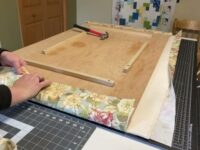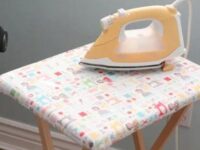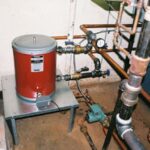Quilting, a cherished art form that stitches together creativity and tradition, demands precision and attention to detail. One often overlooked yet indispensable tool in a quilter’s arsenal is the ironing board. Crafting your own ironing board tailored for quilters can enhance your quilting experience tenfold. From choosing the right materials to adding personalized touches, this article will guide you through the process of How To Make An Ironing Board For Quilters.
Gathering Your Materials and Tools
Before you embark on your ironing board project, it’s essential to gather all the necessary materials and tools. You’ll need sturdy plywood for the base, quality padding, heat-reflective material, a variety of fabrics, a staple gun, screws, a saw, a measuring tape, and more. Collecting these materials ensures a smooth and uninterrupted crafting process.

Choosing the Right Dimensions for Your Ironing Board
The dimensions of your ironing board play a pivotal role in its functionality. Consider your workspace and quilting needs while determining the size. A width of about 18 to 20 inches and a length of 50 to 60 inches is generally ideal. These dimensions provide ample space for pressing seams and working on various quilting projects.
Building the Base Structure: Sturdiness and Stability
The foundation of your ironing board is crucial for its durability. Using a sturdy plywood sheet as the base ensures stability. Craft a simple frame structure from wooden planks, attaching it firmly to the plywood. This frame provides the necessary support to withstand regular usage.
Selecting the Ideal Padding for Your Ironing Board
The padding you choose greatly affects the ironing surface’s quality. High-density foam or batting materials are excellent options. These materials provide the perfect blend of cushioning and firmness, allowing for efficient pressing without creating uneven surfaces.
Picking the Perfect Fabric for the Ironing Surface
Selecting the right fabric for the ironing surface is paramount. A heat-resistant fabric like muslin or cotton twill works well. Ensure it’s tightly woven to prevent any imprints or textures transferring onto your quilt fabrics.
Step-by-Step Guide to Covering the Ironing Board
Covering the ironing board requires precision and attention to detail. Start by layering the padding onto the plywood and securing it with a staple gun. Then, stretch and staple the chosen ironing fabric over the padding. Trim excess fabric for a neat finish.

Adding Convenient Features: Storage and Accessories
Consider incorporating storage options into your ironing board design. Attach pockets or hooks to store pressing tools, scissors, and other quilting necessities. These additions elevate the practicality of your ironing board.
Incorporating Heat-Reflective Layers for Enhanced Ironing
Enhance the efficiency of your ironing board by incorporating heat-reflective materials. Aluminum-coated heat-resistant fabrics help distribute heat evenly, minimizing the need for repeated pressing.
Personalization: Decorating Your Ironing Board to Match Your Style
Infuse your creativity into your ironing board’s appearance. Choose a fabric that matches your sewing room’s decor or personalize it with appliqué, embroidery, or fabric paints. Your ironing board can be as stylish as it is functional.
Ensuring Safety: Tips for Proper Usage and Maintenance
Safety should never be overlooked. Place your ironing board on a stable surface and use a heatproof cover. Regularly inspect and tighten screws to maintain its sturdiness. Always store your ironing tools safely to prevent accidents.
Benefits of a Custom Ironing Board for Quilters
Crafting a custom ironing board offers numerous advantages for quilters. The tailored dimensions, suitable padding, and efficient heat distribution enhance the pressing process, resulting in professionally finished quilting projects.

Comparing Homemade vs. Store-Bought Ironing Boards
Explore the differences between homemade and store-bought ironing boards. While store-bought options offer convenience, a custom-made ironing board ensures a personalized experience that perfectly aligns with your quilting needs.
Testimonials: Quilters Share Their DIY Ironing Board Experiences
Real-life experiences from fellow quilters who have created their ironing boards shed light on the practicality and satisfaction of this DIY project. Learn from their successes and tips for a smoother crafting process.
Start Quilting with Confidence: Enjoy Your Professional Homemade Ironing Board
Armed with your homemade ironing board, embark on your quilting projects with renewed confidence. The efficiency, convenience, and personal touch of your ironing board will undoubtedly enhance your quilting journey.





